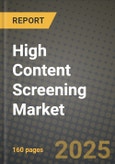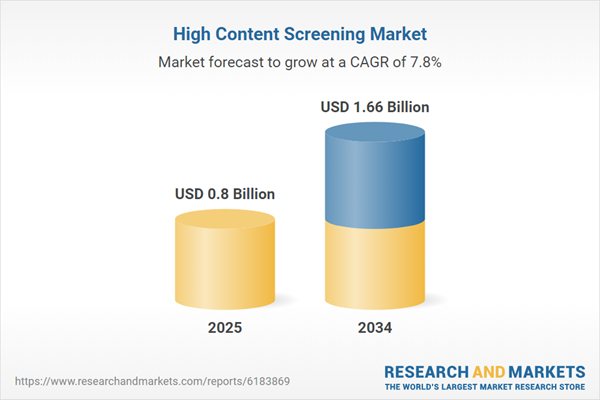High Content Screening Market
The High Content Screening (HCS) market comprises automated cell-imaging instruments, multiplexed assays/reagents, robotics, and analytics software that extract quantitative phenotypes from cells and tissues at scale. Core use cases include phenotypic drug discovery, target validation, secondary screening, mechanism-of-action clustering, predictive safety/tox, and biologics and cell & gene therapy development. Top applications span oncology and immunology models, 3D organoids and spheroids, primary cells, induced pluripotent stem cell (iPSC) derivatives, and CRISPR-edited panels. Key trends center on AI/ML for image segmentation and phenotype calling, cloud data lakes for multi-site workflows, label-efficient “cell painting” and multiplex immunofluorescence, live-cell kinetic assays, and microphysiological systems that better recapitulate human biology. Growth drivers include the shift toward phenotypic-first discovery, rising complexity of biologics, the need to triage candidates earlier with human-relevant models, and expanding regulatory interest in new approach methodologies. The competitive landscape features global life-science platforms and specialty imaging innovators competing on optical performance, speed, assay depth, and software ecosystems - along with integrated robotics, LIMS connectivity, and enterprise analytics. Vendors differentiate via turnkey 3D workflows, AI pipelines, curated assay kits, and service/consulting benches that shorten time to productivity. Barriers include capital intensity, assay development expertise, data governance and storage costs, and reproducibility across sites. Overall, HCS is evolving from instrument-centric purchases to end-to-end, data-driven platforms where biological fidelity, analytics accuracy, and workflow scalability determine return on investment.High Content Screening Market Key Insights
- Phenotype-first discovery scales up: R&D teams increasingly start with unbiased phenotypes (cell painting, multiplex IF) to cluster MoA and prioritize hits before target fixation, improving downstream success and cutting false positives.
- AI moves from pilot to production: Deep learning now underpins segmentation, rare-event detection, and morphology embeddings; the winning stacks pair curated training data with explainable outputs and QC dashboards for auditability.
- 3D and complex co-cultures mainstream: Organoids, tumor-immune co-cultures, and barrier models (BBB, gut) lift translational relevance but require optimized clearing, staining, and volumetric imaging with robust analysis pipelines.
- Live-cell kinetics add decision power: Non-perturbing reporters and environmental control enable trajectory-level insights (proliferation, apoptosis, synapse formation), supporting richer PK/PD hypotheses and earlier fail-fast calls.
- Assay kits shorten onboarding: Pre-validated panels for toxicity, DNA damage, mitochondrial health, and immuno-modulation reduce assay-dev burden and standardize results across sites and CRO partners.
- Data fabric is a bottleneck and a moat: Cloud LIMS integration, FAIR data models, and governance for petabyte-scale images are decisive; platforms with APIs and containerized analytics win multi-site deployments.
- CRISPR and HCS converge: Arrayed/pooled perturbation screens with high-content readouts reveal genotype-phenotype maps; image-based CRISPR QC supports cell therapy manufacturing and potency testing.
- Throughput vs. resolution trade-offs evolve: Fast sCMOS cameras, parallel illumination, and smarter sampling deliver plate speeds without sacrificing Z-stacks and spectral multiplexing, improving cost per data point.
- Quality and reproducibility are king: Reference standards, automated focus/QC, and cross-lab benchmarking programs are now purchasing criteria, not afterthoughts - especially for regulated adjacent workflows.
- Services and partnerships expand access: CROs and vendor-run centers offer screen design, execution, and analytics as a service, enabling smaller biotechs and academic groups to run industrial-grade HCS programs.
High Content Screening Market Reginal Analysis
North America
Adoption is driven by deep biotech pipelines, venture-backed platform companies, and large pharma standardizing on enterprise HCS stacks. Strong CRO ecosystems and core facilities accelerate access to 3D and live-cell workflows. Data governance, AI validation, and integration with ELN/LIMS are advanced, supporting multi-site studies. Procurement emphasizes turnkey assays, analytics transparency, and vendor training to compress time to first screen.Europe
A collaborative academic-industry network and funding for new approach methodologies underpin broad use, particularly for toxicology and phenotypic discovery. Emphasis on data integrity, reproducibility, and sustainability favors standardized workflows and shared infrastructures. Organoid consortia, imaging hubs, and cross-border projects drive method harmonization. Buyers reward open APIs, strong audit trails, and evidence of inter-lab concordance.Asia-Pacific
Rapid biopharma expansion and government-backed research programs fuel instrument installations and local consumables manufacturing. Japan, South Korea, China, Australia, and India scale 3D models and AI analytics, with increasing demand for end-to-end automation and cloud collaboration. Price-performance and service footprint are decisive, while partnerships between universities, hospitals, and domestic biotechs broaden adoption.Middle East & Africa
Growth concentrates in medical cities and flagship universities investing in advanced imaging cores. Procurement favors robust, easy-to-train systems and vendor-led method transfers. Many complex 3D and serial projects run via collaborations with European/North American hubs. Emphasis is on building talent, standard operating procedures, and reliable service contracts to ensure uptime.South & Central America
National research institutes and select pharma centers lead adoption, focusing on toxicity, infectious disease, and oncology models. Access to vendor services and regional CRO support is key for scaling complex screens. Currency and import dynamics elevate the appeal of modular systems, validated assay kits, and remote analytics. Training programs and consortia improve reproducibility and data comparability across labs.High Content Screening Market Segmentation
By Product
- Instruments
- Consumables
- Software
- Services
By Application
- Primary and Secondary Screening
- Target Identification and Validation
- Toxicity Studies
- Compound Profiling
- Others
By End-User
- Pharmaceutical and Biotechnology Companies
- Academic and Government Institutions
- Contract Research Organization
Key Market players
Thermo Fisher Scientific, Revvity (formerly PerkinElmer), Molecular Devices (Danaher), Yokogawa Electric Corporation, GE Healthcare, BD Biosciences (Becton, Dickinson and Company), Agilent Technologies (BioTek Instruments), Tecan Group, Olympus Corporation (Evident), Nikon Instruments Inc., ZEISS, Sartorius (Essen BioScience), Andor Technology (Oxford Instruments), Keyence Corporation, BMG LABTECHHigh Content Screening Market Analytics
The report employs rigorous tools, including Porter’s Five Forces, value chain mapping, and scenario-based modelling, to assess supply-demand dynamics. Cross-sector influences from parent, derived, and substitute markets are evaluated to identify risks and opportunities. Trade and pricing analytics provide an up-to-date view of international flows, including leading exporters, importers, and regional price trends.Macroeconomic indicators, policy frameworks such as carbon pricing and energy security strategies, and evolving consumer behaviour are considered in forecasting scenarios. Recent deal flows, partnerships, and technology innovations are incorporated to assess their impact on future market performance.
High Content Screening Market Competitive Intelligence
The competitive landscape is mapped through proprietary frameworks, profiling leading companies with details on business models, product portfolios, financial performance, and strategic initiatives. Key developments such as mergers & acquisitions, technology collaborations, investment inflows, and regional expansions are analyzed for their competitive impact. The report also identifies emerging players and innovative startups contributing to market disruption.Regional insights highlight the most promising investment destinations, regulatory landscapes, and evolving partnerships across energy and industrial corridors.
Countries Covered
- North America - High Content Screening market data and outlook to 2034
- United States
- Canada
- Mexico
- Europe - High Content Screening market data and outlook to 2034
- Germany
- United Kingdom
- France
- Italy
- Spain
- BeNeLux
- Russia
- Sweden
- Asia-Pacific - High Content Screening market data and outlook to 2034
- China
- Japan
- India
- South Korea
- Australia
- Indonesia
- Malaysia
- Vietnam
- Middle East and Africa - High Content Screening market data and outlook to 2034
- Saudi Arabia
- South Africa
- Iran
- UAE
- Egypt
- South and Central America - High Content Screening market data and outlook to 2034
- Brazil
- Argentina
- Chile
- Peru
Research Methodology
This study combines primary inputs from industry experts across the High Content Screening value chain with secondary data from associations, government publications, trade databases, and company disclosures. Proprietary modeling techniques, including data triangulation, statistical correlation, and scenario planning, are applied to deliver reliable market sizing and forecasting.Key Questions Addressed
- What is the current and forecast market size of the High Content Screening industry at global, regional, and country levels?
- Which types, applications, and technologies present the highest growth potential?
- How are supply chains adapting to geopolitical and economic shocks?
- What role do policy frameworks, trade flows, and sustainability targets play in shaping demand?
- Who are the leading players, and how are their strategies evolving in the face of global uncertainty?
- Which regional “hotspots” and customer segments will outpace the market, and what go-to-market and partnership models best support entry and expansion?
- Where are the most investable opportunities - across technology roadmaps, sustainability-linked innovation, and M&A - and what is the best segment to invest over the next 3-5 years?
Your Key Takeaways from the High Content Screening Market Report
- Global High Content Screening market size and growth projections (CAGR), 2024-2034
- Impact of Russia-Ukraine, Israel-Palestine, and Hamas conflicts on High Content Screening trade, costs, and supply chains
- High Content Screening market size, share, and outlook across 5 regions and 27 countries, 2023-2034
- High Content Screening market size, CAGR, and market share of key products, applications, and end-user verticals, 2023-2034
- Short- and long-term High Content Screening market trends, drivers, restraints, and opportunities
- Porter’s Five Forces analysis, technological developments, and High Content Screening supply chain analysis
- High Content Screening trade analysis, High Content Screening market price analysis, and High Content Screening supply/demand dynamics
- Profiles of 5 leading companies - overview, key strategies, financials, and products
- Latest High Content Screening market news and developments
Additional Support
With the purchase of this report, you will receive:- An updated PDF report and an MS Excel data workbook containing all market tables and figures for easy analysis.
- 7-day post-sale analyst support for clarifications and in-scope supplementary data, ensuring the deliverable aligns precisely with your requirements.
- Complimentary report update to incorporate the latest available data and the impact of recent market developments.
This product will be delivered within 1-3 business days.
Table of Contents
Companies Mentioned
- Thermo Fisher Scientific
- Revvity (formerly PerkinElmer)
- Molecular Devices (Danaher)
- Yokogawa Electric Corporation
- GE Healthcare
- BD Biosciences (Becton Dickinson and Company)
- Agilent Technologies (BioTek Instruments)
- Tecan Group
- Olympus Corporation (Evident)
- Nikon Instruments Inc.
- ZEISS
- Sartorius (Essen BioScience)
- Andor Technology (Oxford Instruments)
- Keyence Corporation
- BMG LABTECH
Table Information
| Report Attribute | Details |
|---|---|
| No. of Pages | 160 |
| Published | November 2025 |
| Forecast Period | 2025 - 2034 |
| Estimated Market Value ( USD | $ 0.8 Billion |
| Forecasted Market Value ( USD | $ 1.66 Billion |
| Compound Annual Growth Rate | 7.8% |
| Regions Covered | Global |
| No. of Companies Mentioned | 15 |









